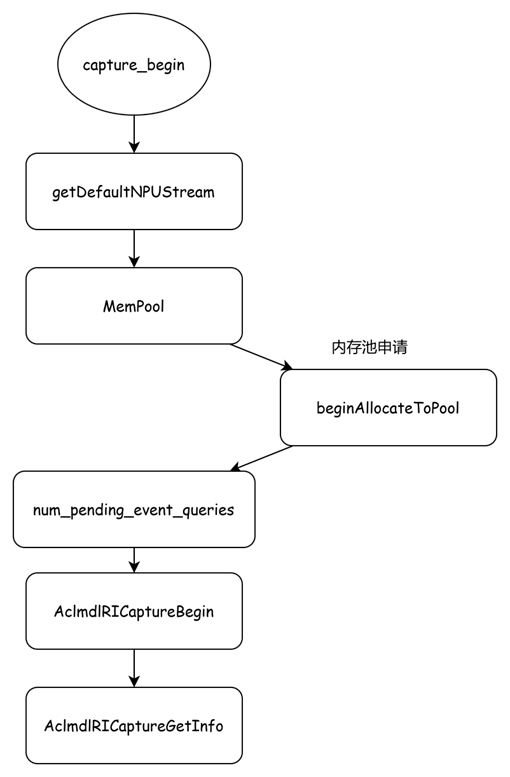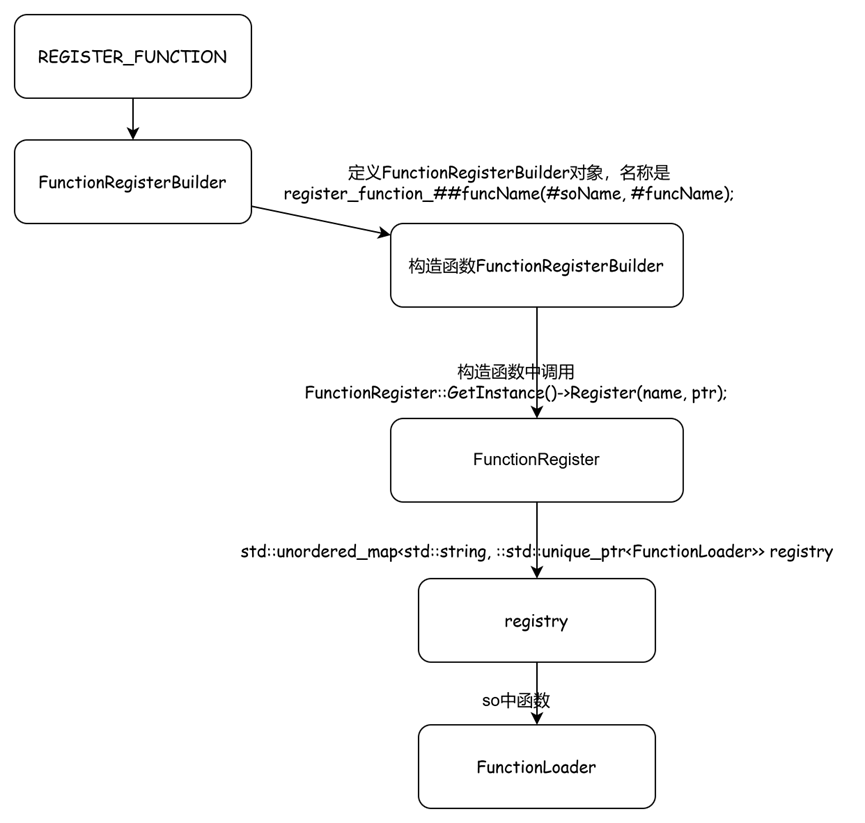1 回顾
在上一章Ascend的aclgraph(六)AclConcreteGraph中提到了capture_begin和capture_end两个函数,这 2 个函数是 pybind 形式,调用到 torch_npu 中去执行。大概流程图如下:
def __enter__(self): # Free as much memory as we can for the graph torch.npu.synchronize() gc.collect() torch.npu.empty_cache()
# Stackoverflow seems comfortable with this pattern self.stream_ctx.__enter__()
self.npu_graph.capture_begin( *self.pool, capture_error_mode=self.capture_error_mode )
def __exit__(self, exc_type, exc_value, traceback): self.npu_graph.capture_end() self.stream_ctx.__exit__(exc_type, exc_value, traceback)
复制代码
2 capture_begin
在torchair进入torch_npu之前,首先进行了算子同步、python 的垃圾回收、缓存清理等操作,然后调用进入到torch_npu的 c++侧,
def( "capture_begin", [](c10_npu::NPUGraph& self, std::optional<c10_npu::MempoolId_t> pool_opt, std::string capture_error_mode) { aclmdlRICaptureMode capture_mode; c10_npu::MempoolId_t pool = pool_opt.has_value() ? pool_opt.value() : c10_npu::MempoolId_t{0, 0}; if (capture_error_mode == "global") { capture_mode = aclmdlRICaptureMode::ACL_MODEL_RI_CAPTURE_MODE_GLOBAL; } else if (capture_error_mode == "thread_local") { capture_mode = aclmdlRICaptureMode::ACL_MODEL_RI_CAPTURE_MODE_THREAD_LOCAL; } else if (capture_error_mode == "relaxed") { capture_mode = aclmdlRICaptureMode::ACL_MODEL_RI_CAPTURE_MODE_RELAXED; } else { TORCH_CHECK( false, "Unknown capture error mode. Expected `global`, `thread_local`, or `relaxed`, got ", capture_error_mode); } return self.capture_begin(pool, capture_mode); }, py::arg("pool"), py::arg("capture_error_mode"), py::call_guard<py::gil_scoped_release>())
复制代码
capture_begin首先执行的是上述的 lamda 表达式中的内容,主要是对 capture_mode 进行了判断,还记得这几个 mode 模式之间的区别不?
该参数用于指定图形捕获流中的 aclmdlRICaptureMode。可以是“全局”、“线程本地”或“宽松”。在 NPU 图形捕获期间,某些操作(如 npuMalloc)可能会不安全。
除非您熟悉 aclmdlRICaptureMode_,否则请勿更改此设置。
然后就正式进入到 c++侧capture_begin函数,首先结合代码
void NPUGraph::capture_begin(MempoolId_t pool, aclmdlRICaptureMode capture_mode){ static const auto _task_queue_enable = c10_npu::option::OptionsManager::GetTaskQueueEnable(); TORCH_CHECK(_task_queue_enable != 2, "Do not support TASK_QUEUE_ENABLE = 2 during NPU graph capture, please " "export TASK_QUEUE_ENABLE=1/0.", PTA_ERROR(ErrCode::NOT_SUPPORT));
TORCH_CHECK(!has_graph_exec_, "This NPUGraph instance already owns a captured graph. " "To capture a new graph, create a new instance.");
auto stream = c10_npu::getCurrentNPUStream();
TORCH_CHECK(stream != c10_npu::getDefaultNPUStream(), "NPU graphs must be captured on a non-default stream. " "(However, after capture, it's ok to replay them on the " "default stream.)");
capture_stream_ = stream; capture_dev_ = c10_npu::current_device();
if (pool.first != 0 || pool.second != 0) { // Either value being nonzero means the user supplied a pool to share. // But only one should be nonzero. // If pool was created by another graph's capture_begin, first should be nonzero. // If pool was created by graph_pool_handle, second should be nonzero. TORCH_INTERNAL_ASSERT(!(pool.first && pool.second)); mempool_id_ = pool; } else { // User did not ask us to share a mempool. Create graph pool handle using is_user_created=false. // Sets just the first value, to distinguish it from MempoolId_ts created by graph_pool_handle(). auto mempool = c10_npu::MemPool({}, false); mempool_id_ = mempool.id(); TORCH_INTERNAL_ASSERT(mempool_id_.first > 0); }
// Addendum: beginAllocateStreamToPool is now called before cudaStreamBeginCapture to prevent an // autograd thread's free() call triggering an invalid cudaEventRecord in the caching allocator // due to the capture status being updated _after_ a capture had already started. c10_npu::NPUCachingAllocator::beginAllocateToPool(capture_dev_, mempool_id_, [this](aclrtStream stream) { aclmdlRICaptureStatus status; aclmdlRI model_ri; NPU_CHECK_ERROR(c10_npu::acl::AclmdlRICaptureGetInfo(stream, &status, &model_ri)); return status == aclmdlRICaptureStatus::ACL_MODEL_RI_CAPTURE_STATUS_ACTIVE && model_ri == model_ri_; });
// At this point, any NCCL watchdogs should be aware that we are in capture mode // and therefore should not enqueue any additional work that could be event-queried. // We still must wait on any existing work that has not been cleaned up. while (num_pending_event_queries()) { TORCH_WARN_ONCE("Waiting for pending NCCL work to finish before starting graph capture."); std::this_thread::sleep_for( std::chrono::milliseconds(kSynchronizeBusyWaitMillis)); }
// cudaStreamCaptureModeGlobal is the most conservative option to // prevent potentially unsafe CUDA API calls during capture. NPU_CHECK_ERROR(c10_npu::acl::AclmdlRICaptureBegin(capture_stream_, capture_mode));
aclmdlRICaptureStatus status; NPU_CHECK_ERROR(c10_npu::acl::AclmdlRICaptureGetInfo(stream, &status, &model_ri_)); TORCH_INTERNAL_ASSERT(status == aclmdlRICaptureStatus::ACL_MODEL_RI_CAPTURE_STATUS_ACTIVE);}
复制代码
给出流程图
mempool 是图 capture 用来做显存复用的,每次 cupture 都有一个PrivatePool对象。PrivatePool对象可以被多个 capture graph 共用,使用 mempool_id 来管理。
// Called by NPUGraph::capture_beginvoid beginAllocateToPool(MempoolId_t mempool_id, std::function<bool(aclrtStream)> filter){ std::lock_guard<std::recursive_mutex> lock(mutex); auto it = graph_pools.find(mempool_id); if (it == graph_pools.end()) { // mempool_id does not reference an existing pool. Make a new pool for // this capture. graph_pools.emplace(mempool_id, std::make_unique<PrivatePool>()); } else { // mempool_id references an existing pool, which the current capture will // share. Check this pool is live (at least one other capture already // references it). TORCH_INTERNAL_ASSERT(it->second->use_count > 0); it->second->use_count++; } for (auto it2 = captures_underway.begin(); it2 != captures_underway.end(); ++it2) { TORCH_CHECK(it2->first != mempool_id, "beginAllocateToPool: already recording to mempool_id"); } captures_underway.emplace_back(mempool_id, std::move(filter));}
复制代码
captures_underway用来继续当前正在图 capture 中使用到的mempool_id。
captures_underway 用于跟踪我们是否将某些分配重定向到特定池。// 大多数情况下它是空的,在这种情况下,malloc 可以避免在热路径上调用 aclrtStreamGetCaptureInfo。
num_pending_event_queries是在图开始 capture 之前,等待所有 nccl 的任务完成。AclmdlRICaptureBegin 函数核心的 cupture 函数
aclError AclmdlRICaptureBegin(aclrtStream stream, aclmdlRICaptureMode mode){ typedef aclError (*AclmdlRICaptureBegin)(aclrtStream, aclmdlRICaptureMode); static AclmdlRICaptureBegin func = nullptr; if (func == nullptr) { func = (AclmdlRICaptureBegin) GET_FUNC(aclmdlRICaptureBegin); }
TORCH_CHECK(func, "Failed to find function aclmdlRICaptureBegin", PTA_ERROR(ErrCode::NOT_FOUND)); return func(stream, mode);}
复制代码
GET_FUNC的宏定义如下:
#define GET_FUNC(funcName) \ GET_FUNCTION(libascendcl, funcName)
复制代码
整个代码的逻辑就是:
先定义了一个函数指针类型 AclmdlRICaptureBegin,它指向一个接受两个参数(一个 aclrtStream 和一个 aclmdlRICaptureMode)并返回一个 aclError 值的函数。
然后定义了一个函数级的静态成员变量 AclmdlRICaptureBegin
尝试通过 GET_FUNC(aclmdlRICaptureBegin) 动态加载 aclmdlRICaptureBegin 函数,并将其地址赋值给 func。也就是从libascendcl.so中查找 aclmdlRICaptureBegin 的函数
然后调用 func 执行具体的函数。说白了,关键函数还是藏在libascendcl.so里面。
先弄明白aclmdlRICaptureBegin是什么时候注册进去的?
#define REGISTER_LIBRARY(soName) \ auto library_##soName = \ ::std::unique_ptr<c10_npu::option::FunctionLoader>(new c10_npu::option::FunctionLoader(#soName)); \ static c10_npu::option::register_function::FunctionRegisterBuilder \ register_library_##soName(#soName, library_##soName);
#define REGISTER_FUNCTION(soName, funcName) \ static c10_npu::option::register_function::FunctionRegisterBuilder \ register_function_##funcName(#soName, #funcName);
#define GET_FUNCTION(soName, funcName) \ c10_npu::option::register_function::FunctionRegister::GetInstance()->Get(#soName, #funcName);
复制代码
这里看到了REGISTER_FUNCTION宏定义。根据小编的理解,先给出流程图:
这里关注FunctionLoader这个对象,弄明白为什么registry这个 map 里面存储的不是函数对象,而是需要一个类对象(智能指针形式)。先给出FunctionLoader的定义:
class FunctionLoader {public: /** ctr */ explicit FunctionLoader(const std::string& filename); /** dectr */ ~FunctionLoader(); /** set function name */ void Set(const std::string& name); /** get function address by function name. */ void* Get(const std::string& name);private: mutable std::mutex mu_; std::string fileName; void* handle = nullptr; mutable std::unordered_map<std::string, void*> registry;}; // class FunctionLoader
复制代码
发现,真正存储函数指针的地方,应该是FunctionLoader 中的registry。Set函数
void FunctionLoader::Set(const std::string &name){ this->registry[name] = nullptr;}
复制代码
Set函数执行的时候,在registry中存储了对应的 key 值,value 设置为 nullptr。Get函数
void *FunctionLoader::Get(const std::string &name){ // 缓存 if (this->handle == nullptr) { auto handle = dlopen(this->fileName.c_str(), RTLD_LAZY | RTLD_GLOBAL); if (handle == nullptr) { AT_ERROR(dlerror()); return nullptr; } this->handle = handle; }
auto itr = registry.find(name); if (itr == registry.end()) { AT_ERROR("function(", name, ") is not registered."); return nullptr; }
if (itr->second != nullptr) { return itr->second; }
auto func = dlsym(this->handle, name.c_str()); if (func == nullptr) { return nullptr; } this->registry[name] = func; return func;}
复制代码
先通过dlopen打开了对应的 so,如上就是libascendcl.so,并缓存了对应的 handle(在FunctionLoader析构的时候调用 dlclose)然后通过dlsym在 so 中去查找对应的函数名称。
读到这里,还没弄明白 aclmdlRICaptureBegin 到底做的是什么事情?在昇腾官网上搜索到如下信息:https://www.hiascend.com/document/detail/zh/canncommercial/81RC1/apiref/appdevgapi/aclcppdevg_03_1782.html函数原型 aclError aclmdlRICaptureBegin(aclrtStream stream, aclmdlRICaptureMode mode)
接口解释开始捕获 Stream 上下发的任务。
在aclmdlRICaptureBegin和aclmdlRICaptureEnd接口之间,所有在指定 Stream 上下发的任务不会立即执行,而是被暂存在系统内部模型运行实例中,只有在调用aclmdlRIExecuteAsync接口执行模型推理时,这些任务才会被真正执行,以此减少 Host 侧的任务下发开销。任务执行完毕后,若无需再使用内部模型,可调用 aclmdlRIDestroy 接口及时销毁该资源。
aclmdlRICaptureBegin和aclmdlRICaptureEnd接口要成对使用,且两个接口中的 Stream 应相同。在这两个接口之间,可以调用aclmdlRICaptureGetInfo接口获取捕获信息,调用aclmdlRICaptureThreadExchangeMode接口切换当前线程的捕获模式。此外,在调用aclmdlRICaptureEnd接口之后,还可以调用aclmdlRIDebugPrint接口打印模型信息,这在维护和测试场景下有助于问题定位。
在aclmdlRICaptureBegin和aclmdlRICaptureEnd接口之间捕获的任务,若要更新任务(包含任务本身以及任务的参数信息),则需在aclmdlRICaptureTaskGrpBegin、aclmdlRICaptureTaskGrpEnd接口之间下发后续可能更新的任务,给任务打上任务组的标记,然后在aclmdlRICaptureTaskUpdateBegin、aclmdlRICaptureTaskUpdateEnd接口之间更新任务的输入、输出信息。
说明在 aclmdlRICaptureBegin 和 aclmdlRICaptureEnd 接口之间捕获到的任务会暂存在系统内部模型运行实例中,随着任务数量的增加,以及通过 Event 推导、内部任务的操作,导致更多的 Stream 进入捕获状态,Stream 资源被不断消耗,最终可能会导致 Stream 资源不足(Stream 数量限制请参见 aclrtCreateStream),因此需提前规划好 Stream 的使用、关注捕获的任务数量。
这里也说明了 stream 管理,在 mempool 使用的重要性。
3 小结
最终 device 侧如何根据 aclmdlRICaptureBegin 和 aclmdlRICaptureEnd 捕捉,存储相关的节点,当前是没有对外代码说明的,无从看起。但是能知道,算子的执行信息都是在 device 侧的,并没有在 host 上留下信息,那么跟以前的 FX graph 又是什么关系呢?先记住这些疑问,后续继续探讨。下一篇章,看下 capture_end 又做了些什么事情。















评论